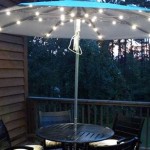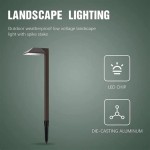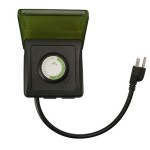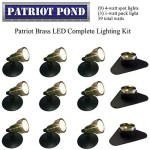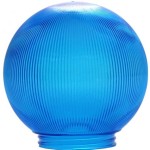Outdoor Lighting For Patios: Illuminating Your Outdoor Living Space
Outdoor patios offer extensions of indoor living spaces, providing areas for relaxation, dining, and entertaining. To maximize the enjoyment of a patio, especially during evenings and nighttime, appropriate and well-planned outdoor lighting is essential. Effective patio lighting enhances ambiance, increases safety, and extends the usability of the space. A well-lit patio becomes an inviting and functional area, transforming the outdoor experience.
Selecting the correct outdoor lighting for a patio involves considering a multitude of factors, including the patio's size and layout, the desired aesthetic, and the intended use of the space. Different types of lighting fixtures cater to various needs, and a combination of lighting techniques often produces the most effective and visually appealing results. This article will explore key considerations for designing and implementing outdoor lighting for patios, covering different types of fixtures, lighting techniques, and practical tips for achieving optimal illumination.
Key Considerations Before Selecting Lighting
Before purchasing any lighting fixtures, a comprehensive assessment of the patio area is crucial. This includes evaluating the space's dimensions, identifying existing architectural features, and defining the primary purpose of the patio. Understanding these factors will guide the selection of appropriate lighting solutions and ensure that the lighting design complements the overall aesthetic of the outdoor space.
Specifically, the size of the patio will influence the number and intensity of lighting fixtures needed. A large patio will require more lights than a small one to achieve adequate illumination. The layout of the patio, including features like pergolas, walls, and landscaping, will determine the placement of lights and the types of fixtures that will be most effective. For example, a pergola can support string lights or pendant lights, while walls can accommodate sconces or spotlights. Defining the patio's primary purpose, whether it's for dining, relaxing, or entertaining, will help determine the appropriate lighting levels and the desired ambiance. A dining area may require brighter, more focused light, while a relaxation area may benefit from softer, more diffused light.
Furthermore, energy efficiency and cost-effectiveness are important factors to consider. LED lighting is generally preferred due to its long lifespan and low energy consumption compared to traditional incandescent or halogen bulbs. While the initial cost of LED fixtures may be higher, the long-term savings on electricity bills can be significant. Smart lighting options, such as dimmers and timers, can also contribute to energy savings by allowing users to control the intensity and duration of the lighting.
Finally, the overall aesthetic of the patio and the surrounding landscape should guide the selection of lighting fixtures. The style of the fixtures should complement the existing architecture and design elements. For instance, a modern patio may benefit from sleek, minimalist lighting fixtures, while a rustic patio may be enhanced by more traditional, ornate fixtures. Considering the color and material of the fixtures will also contribute to a cohesive and visually appealing outdoor space.
Types of Outdoor Patio Lighting
A wide variety of outdoor lighting options exist, each offering unique benefits and functionalities. Understanding the different types of lighting fixtures is essential for creating a well-designed and functional patio lighting system. The selection should consider the desired ambiance, the specific lighting needs of the patio area, and the overall aesthetic of the outdoor space.
String lights, also known as bistro lights or fairy lights, are a popular choice for creating a warm and inviting ambiance. These lights are typically strung across a patio or pergola, providing a soft, diffused glow. String lights are versatile and can be used to create a festive or romantic atmosphere. They are also relatively easy to install and can be a cost-effective lighting solution.
Path lighting is used to illuminate walkways and pathways, enhancing safety and guiding guests through the outdoor space. Path lights are typically low to the ground and emit a soft light that illuminates the path without being overly bright. These lights can be solar-powered, electric-powered, or battery-operated. Path lights can also be strategically placed to highlight landscape features, such as plants or trees.
Spotlights are directional lights that can be used to highlight specific features, such as architectural details, plants, or water features. Spotlights are typically more powerful than other types of outdoor lighting and can be used to create dramatic effects. They can be mounted on walls, trees, or stakes in the ground. Adjustable spotlights allow for flexible aiming of the light beam.
Wall sconces are mounted on walls and provide ambient lighting. They can be used to illuminate doorways, seating areas, or other sections of the patio. Wall sconces come in a variety of styles, from traditional to modern, and can add a decorative touch to the outdoor space. They are also a good option for areas where space is limited.
Pendant lights are suspended from a ceiling or pergola and provide focused lighting. They are often used over dining tables or seating areas. Pendant lights can add a touch of elegance to a patio and can be a statement piece. The height of the pendant light should be carefully considered to avoid blocking views or creating glare.
Floodlights are high-intensity lights that are used to illuminate large areas. They are often used for security purposes or to illuminate entire patios. Floodlights can be mounted on walls, poles, or trees. However, the use of floodlights should be carefully considered to avoid creating light pollution or disturbing neighbors. Consider using motion-activated floodlights for security purposes, as they only turn on when motion is detected.
Deck lights are specifically designed for installation on decks and railings. They are typically small and low-profile, providing subtle illumination. Deck lights can be used to enhance safety and create a warm ambiance. They come in various styles, including recessed lights, surface-mounted lights, and post cap lights.
Outdoor Lighting Techniques for Optimal Ambiance
Beyond selecting the right types of fixtures, mastering various lighting techniques is crucial for creating a captivating and functional patio environment. These techniques involve strategic placement and utilization of light to achieve specific visual and functional effects.
Layering light involves combining different types of lighting to create a well-balanced and visually appealing effect. Typically, this involves layering ambient, task, and accent lighting. Ambient lighting provides overall illumination for the patio, while task lighting is used for specific activities, such as dining or reading. Accent lighting is used to highlight architectural features, plants, or other decorative elements. By layering light, a more dynamic and interesting outdoor space can be created.
Up-lighting involves directing light upwards, typically to highlight trees, architectural features, or walls. This technique can create a dramatic effect and add depth to the outdoor space. Up-lighting can also be used to create a sense of height and grandeur. It's important to consider the angle of the light beam to avoid creating glare or disturbing neighbors. Employing shielded fixtures can help direct light and minimize light pollution.
Down-lighting involves directing light downwards, typically from a tree, pergola, or wall. This technique can create a more intimate and inviting atmosphere. Down-lighting can also be used to create pools of light that highlight specific areas, such as seating areas or dining tables. Careful placement is necessary to avoid harsh shadows.
Silhouetting involves placing a light behind an object to create a silhouette effect. This technique can be used to highlight plants, sculptures, or other decorative elements. Silhouetting can add a touch of mystery and drama to the outdoor space. Selecting the right type of light and adjusting its intensity are key to achieving the desired effect.
Washing involves spreading light evenly across a surface, such as a wall or fence. This technique can be used to create a soft and diffused light that enhances the texture and color of the surface. Washing can also be used to create a sense of depth and dimension. Using wide-beam spotlights or floodlights can achieve this effect.
Path lighting techniques involve not only illuminating the path itself but also considering the placement and spacing of the lights to create a visually appealing effect. Lights should be placed close enough together to provide adequate illumination, but far enough apart to avoid creating a runway effect. Staggering the lights on either side of the path can create a more natural and organic look.
Practical Tips for Installing and Maintaining Outdoor Lighting
Proper installation and maintenance are critical for ensuring the longevity and performance of outdoor lighting systems. Adhering to safety guidelines and performing regular maintenance can prevent costly repairs and ensure that the patio lighting remains functional and visually appealing.
Before starting any electrical work, ensure that the power is turned off at the circuit breaker. It is highly recommended to consult with a qualified electrician for any complex wiring or installation tasks. Following all local electrical codes and regulations is essential for safety.
When installing outdoor lighting fixtures, use weatherproof connectors and wiring to protect against moisture and corrosion. Ensure that the fixtures are securely mounted and properly grounded. Choose durable materials that can withstand the elements, such as stainless steel or powder-coated aluminum.
Regularly clean the lighting fixtures to remove dirt, dust, and debris. Use a soft cloth and mild detergent to avoid scratching the surfaces. Check the bulbs regularly and replace them as needed. LED bulbs typically have a longer lifespan than traditional bulbs, but they may still need to be replaced periodically.
Inspect the wiring and connections regularly for any signs of damage or corrosion. Repair or replace any damaged components to prevent electrical hazards. Consider using surge protectors to protect outdoor lighting fixtures from power surges.
Trim any overgrown vegetation that may be blocking or interfering with the lighting. Overhanging branches can cast unwanted shadows and reduce the effectiveness of the lighting. Keep the area around the lighting fixtures clear of debris to prevent fire hazards.
Automated lighting controls, such as timers and photocells, can simplify the operation of outdoor lighting systems. Timers can be used to automatically turn the lights on and off at specific times, while photocells can automatically turn the lights on at dusk and off at dawn. These controls can save energy and enhance convenience.
Consider local light pollution ordinances when designing and installing outdoor lighting. Minimize the amount of light that shines onto neighboring properties and reduce the overall amount of light emitted into the night sky. Shielded fixtures and low-intensity bulbs can help reduce light pollution.
By carefully considering these factors and implementing these practical tips, homeowners can create a beautiful, functional, and energy-efficient outdoor lighting system for their patios, enhancing the enjoyment of their outdoor living spaces for years to come.

10 Best Outdoor Lighting Ideas Landscape Design Secrets A Piece Of Rainbow

28 Backyard Lighting Ideas How To Hang Outdoor String Lights

19 Stylish Outdoor Lighting Ideas The Best Patio

5 Outdoor Lighting Upgrades For Your Backyard R I Lampus

Outdoor Lighting Ideas Lowe S

Outdoor Lighting Guide The Home Depot

7 Awesome Outdoor Lighting Ideas For Your Backyard Bob Vila

Outdoor Led Lighting Ideas For Any Style Backyard

13 Outdoor Lighting Tips For A Safe And Inviting Landscape

Everything You Need To Know About Outdoor Lighting
Related Posts

